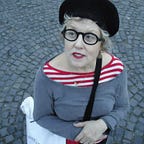Happy 1600th Birthday Venice
Or Is It Various Birthdays?
March 25th was the 1600th birthday of the founding of Venice.
Or so the story goes. It’s a tale of two gentlemen from Padua, a town on the mainland about 30 miles west of Venice. On March 25th, 421 CE they were rowing or sailing in the lagoon and happened upon one of the many small islands, this one called Rivoaltus, that constitute what we now call the city of Venice. The Paduans moored their boat and then put a couple of stones on the ground to mark the moment, and left. In 1097 that spot evolved into the great Rialto Market and Pescaria, or fish market, both bustling places to pick up fresh foods today.
This story popped up in the 14th century, 1000 years after people were living in the lagoon, and no one knows who made it up. That would be like a historian, or storyteller, writing for the first time about the American Revolution 400 years from now and claiming their account was accurate. Americans, however, have a piece of paper dated 1776 and signed by a bunch of guys that make the birthday of this nation credible. But to make the founding of Venice even more confusing, there are other origin stories.
A popular one involves the man who would become the patron Saint of Venice, Mark the Evangelist. According to this legend, when Rome was still in charge of Northern Italy, St. Mark was traveling by boat from the city Acquileia set on the northernmost shore of the Adriatic, to Rome. Mark took a detour into the Venetian Lagoon, or maybe he was blown in there by the will of God or a storm, and landed on a small island in the center. That beachhead was also Rialto. As St. Mark ran aground, an angel appeared and said to him, “Pax tibi, Marce evangelitsa meus. Hic requiescat corpus tuum” (May peace be with you Mark, my evangelist. These words are carved into the open book held in the paw of various winged lion statues around the city). The word of God to St. Mark, then, directed that a city be built there, in the middle of the lagoon, at Rialto.
And then there is the popular story of the many hoards. This one is repeated in every modern guidebook and many popular books on Venetian history — that Venice was created as waves of barbarian hoards ran over Northern Italy and people ran screaming and yelling into the lagoon for safety. First, Atilla the Hun arrived 453 CE, then the Visigoths came around 500, and finally the Lombards in 568. The only written record of any fleeing appeared about 500 years later, and the author, John the Deacon, claimed the last bout was a religious miracle. The reality is that the Huns didn’t take over anything; they were nomads and not settlers and didn’t conquer land for themselves. And there is no real evidence of any sudden mass migrations followed by habitation anywhere in the lagoon. Also, there were over 50 years between each of these events so who exactly ran into the lagoon, and did they run out again after the barbarians left?
The truth is that the lagoon had been occupied for a very long time before any barbarians appeared. Walls inside the church on Torcello, probably the first lagoon island to be permanently occupied, date to the 5th century and there is other church material that dates from the 7th and 8thcentury suggesting continued occupation. Archaeologists have also found a preserved small wooden boat that dates from 425–550 CE and remnants of a wharf or pier in layers below that boat on the island of San Francesco del Deserto in the northeastern part of the lagoon. These finds also underscore the long-term occupation of lagoon islands. That team also took core samples from far below the current floor of the church of San Lorenzo in the Castello district of Venice and dredged up bits of pottery, masonry, brick, and matted reeds. Dated around 550 CE, these construction materials suggest that people were building permanent housing on the shifting sands of Venetian islands; no one puts up brick buildings on the run. Other core samples from Piazza San Marco confirm that residents were using this area regularly by the mid 600s. The archaeologists also discovered that these early Venetians were making islands bigger and shoring them up against erosion with landfill.
People had gradually and continuously come into the lagoon because it was full of fish and wildlife and they didn’t have to deal with Rome or Byzantium. Maybe some even had dwellings both on the mainland and in the lagoon, like vacation homes, but life was not as precarious as the hoards story suggests. The Venetian lagoon was a good, fruitful, place to live.
The origin story of Venice, then, is not one of mystical appearance, or guys from out of town on a mission, but the usual human movement from one place to another where natural resources are more favorable. All that water was good, especially back then when not so much saltwater was encroaching into the lagoon as it is today. Also, being surrounded by water made it hard for those without boats to share the space. But that sort of protection from outsiders lasted only for a few centuries until trade boats brought in more foreign hoards followed in recent times by tourists who arrive by car, boat, bus, plane, and train.
Venice can celebrate any birthday she wishes because the point is that this city and former Republic has been here a very long time. And we join in the celebration and hope she remains immortal.
